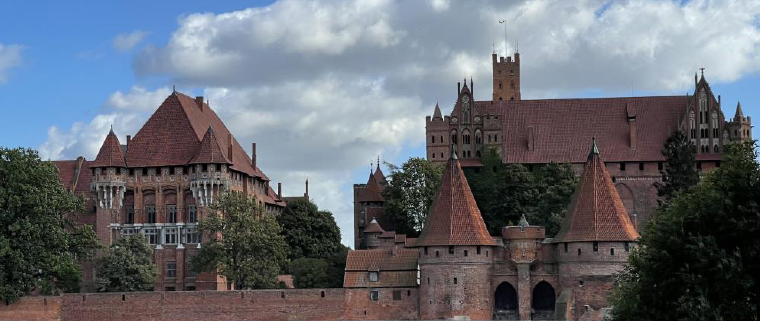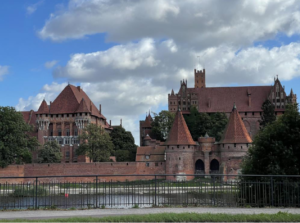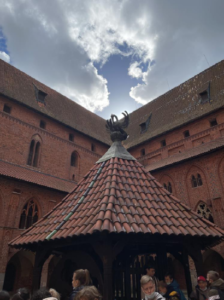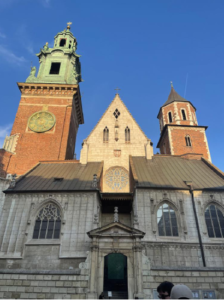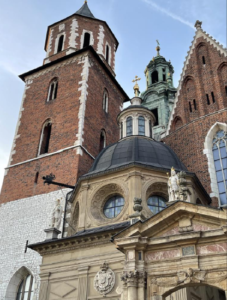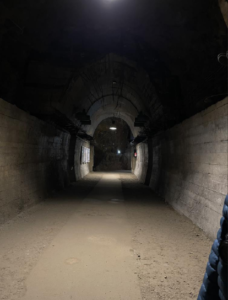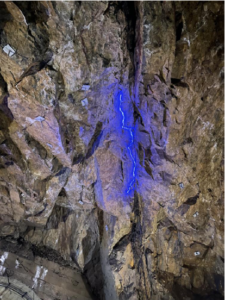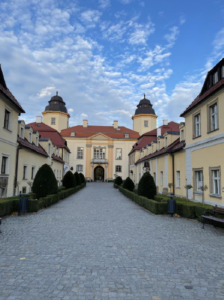Castles: Telling More Than Just Fairytales
By Capriana Cormier
While in Poland, I had been able to visit three impressive castles. Castles are astounding to me; I have always loved them growing up. I have always seen them as magical, whether in fairytales or movies due to the dramatic narrative they have to them, that has always piqued my interest. On the other hand, castles have a beautiful architecture, inside and out. The way they are built, the paintings, chandeliers, and structures have always intrigued me. I saw this when I visited the Malbork, Wawel, and Książ castle. However, the history of these castles is the biggest appeal to them. Each of these three castles tell a different chapter in the story of the last 1,000 years of history in Poland.
In the very north of Poland, near Gdańsk, The Castle of the Teutonic Order in Malbork, also known as the Malbork Castle, was built by the Teutonic Knights in the late 13th century. The Teutonic Order is a group of a Catholics of German origin who created the Teutonic Knights to protect pilgrims moving between the Holy land and the Baltic region. The castle at Malbork tells more than just the history of the Teutonic Knights, it tells the story of the emergence of Poland and Lithuania as major European powers. Lithuania and Poland became a joint superpower during the 15th century when Jagiełło, the Duke of Lithuania, married Jadwiga, also known as Hedwig, king of Poland, according to author Lonnie Johnson. This marriage was beneficial for Poland because it really was the first time Poland emerged as a significant player on the map of Europe.
The main purpose for this marriage was because Poland knew it could not defeat the Teutonic Knights on its own, so rulers looked to Lithuania. Lithuania could also not defeat the knights on their own. Together they defeated the Teutonic Knights in the Battle of Grunwald. For 360 years the Malbork Castle was under the Polish rule during the Polish-Lithuanian Commonwealth. The Polish-Lithuanian Commonwealth was a historical superpower, at its largest the Commonwealth covered 1,000,000 square kilometers, covering a territory running from the Baltic Sea to the Black Sea. The Commonwealth covered the lands of Poland, Lithuania, all of Belarus and Latvia, as well as parts of Ukraine, Estonia, and Russia. At the Commonwealth’s most prime, the capital was in Kraków.
Kraków was the capital of Poland from 1596-1793, the entire time of the Polish-Lithuanian Commonwealth. But during this time, Kraków was a thriving city. In Kraków stands another castle, the Wawel Castle. This castle was a place of residency for Polish kings and other royalty. This castle really shows a time when Poland was in its Golden Age. The Golden Age lasted from the 15th to the 18th century, with the greatest part of this period being the 16th and 17th centuries, according to Culture.Pl. Kraków was the capital of Poland at this time, and the Wawel Castle played a significant role, all the kings were crowned in that castle.
The Wawel castle still fills the Kraków skyline today, and it is part of one of the first UNESCO World Heritage Sites in the world, something which further shows the importance of the historical, and cultural, story this castle has in Polish history. Although today, Kraków is not the capital of Poland anymore, the importance this city, and castle, had in Poland’s past makes learning the history even more interesting.
The last castle I visited is in Wałbrzych, a city in the lower Silesian region of Poland. This castle only recently became part of Poland in the 20th century. Before 1945, the castle was located in Waldenburg, Germany. The castle was occupied by Nazi leadership during the time of 1940-1945, with plans at one point to convert it into a residency for Hitler. At the end of World War II Poland’s borders were shifted. The Soviet Union gave Poland the Lower Silesian Region as compensation for the territories in Poland’s east incorporated into the Soviet Union. This border shift forced the Poles from these eastern regions to relocate to the Lower Silesia region.
Although the castle is fascinating, the real history lies underground. 50 meters, or 165 feet, underneath the Książ castle there are underground tunnels. These tunnels were built for the Nazis by prisoners from concentration camps during the Holocaust, many who died while working in these horrid conditions. The underground tunnels remain a mystery for why they were being built, but there is a tragic history of death tied to them.
These castles helped me to understand some of Poland’s most important history, and in a way that was interesting to me. The architecture of the castles is majestic, and really highlights Poland’s extensive history.
Resources

